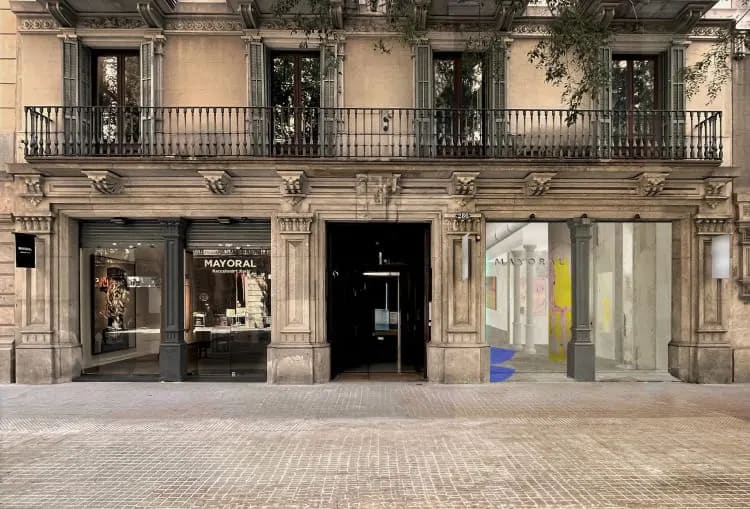Joaquín Torres-García (Montevideo, 1874-1949) —painter, sculptor, writer, theorist and teacher— is recognized worldwide as a canonical figure of modern art. He was the first to link the principles of European Constructivism and Geometric Abstraction to pre-Columbian art, a completely innovative and original approach at the time. Torres-García contributed hugely to the aesthetic and mental decolonization, as regards artistic influences and tastes, of Latin America.
This is the first monographic exhibition devoted to him by the Mayoral gallery, displaying a selection of 18 pieces, including oil paintings, drawings and toys, produced between 1917 and 1937.
In 1936, Joaquín Torres-García introduced the metaphorical image of an upturned America into the manuscript of one of his papers in the journal Círculo y Cuadrado (a continuation of the publication Cercle et Carré, which he founded in Paris in 1930), in which he presented the outline of the continent upside down: the south in the north and north in the south, and Uruguay –his home country– appeared in the centre crossed by a line. The artist wanted to call into question the orientation of the vanguards toward the north, that is to say with Europe and the United States as benchmarks. His north, also understood as Utopia, had to be the geographic south. Torres-García’s theory has been considered by critics as the beginning of the aesthetic decolonization process that took place globally: “The countries of Latin America were already independent but, as has often been argued, the ‘coloniality of power’ survived” (Quijano 20201).
Torres-García pointed out the need to think about the consequences of having been colonies of the Iberian monarchies for centuries and, later, of having been under the hegemony of the United States. This anti-hegemonic approach involving cultural revalorization is framed in the Escuela del Sur (School of the South), which sought freedom from European influence through the development of its own aesthetics, based on the Global South countries’ experiences and traditions (García, 20102).
Before returning to Montevideo, Torres-García developed his artistic practice in cities such as Barcelona, Paris, New York and Madrid. This exhibition displays drawings which reflect the huge influence of the time he spent in New York, where he lived from 1920 to 1922, during which he established the structural matrix of his Constructivist compositions of the 1930s. In the drawing Nueva York (New York) (1929), we observe how elements of the urban landscape structure the composition. Indeed, the structural format of the reticle permits him to balance the vertical and horizontal elements, to frame their symbols in a geometric grid based on the golden ratio creating compositions in which the lines, the geometry and the colour are represented in perfect harmony.
The artist’s aim to promote toy production, and at the same time formal research in this field, was a fundamental reason for travelling to New York. As Luis Pérez-Oramas mentioned in the article in the catalogue published by the MoMA (2016), “His toys were figures of infancy made by an artist fascinated by the infancy of forms. They also marked the infancy of his sculptural practice, and as such would lead to a number of similarly anthropomorphic works”. In short, toys such as those displayed here already expressed the primal schematic representation of his language.
His production goes from the end of the 19th to the mid-20th century, Torres-García’s painting thus evolving from Mediterranean Classicism to periods of Vibrationism, Cubism and Fauvism. We display severa pieces from 1928, such as the oils on canvas Personatges (Characters) and Café de París (Paris Café), the city in which he began to express his different way of doing things. We should also highlight that La Feria (The Fair) (1917) formed part of the retrospective exhibition devoted to him by the MoMA in 2016, as well as having been displayed in prestigious exhibitions of museums such as the MNCARS, the Picasso Museum and the Fundación Joan Miró in Barcelona, among others.
Torres-García was deeply convinced that art and life were the same thing and, therefore, both Constructive Universalism and the Escuela del Sur transcended the boundaries of purely aesthetic theory and had a significant impact on the development of modern art in Latin America and the rest of the world.
1. Quijano, Aníbal (2020): “Colonialidad del poder, eurocentrismo y América Latina”. In: Quijano, Aníbal: Cuestiones y horizontes: de la dependencia histórico-estructural a la colonialidad/descolonialidad del poder. Buenos Aires: Biblioteca CLACSO, pp. 91-146.
2. García, G. (2010). Joaquín Torres García: El sur y la vanguardia. Fondo de Cultura Económica.










